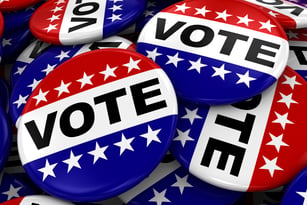Wheelchair users guide to planning to cast your vote - Reeve Foundation
by Stephanie Woodward
 Deciding on the candidates that you support should be the most difficult part of casting your ballot, unfortunately, that’s not always the case for wheelchair users. For some of us, being able to vote takes a bit of extra planning but that should not deter us from participating in the electoral process. Here are a few ways that wheelchair users can plan in advance to cast your ballot:
Deciding on the candidates that you support should be the most difficult part of casting your ballot, unfortunately, that’s not always the case for wheelchair users. For some of us, being able to vote takes a bit of extra planning but that should not deter us from participating in the electoral process. Here are a few ways that wheelchair users can plan in advance to cast your ballot:
- Register to Vote and Update Your Address as Necessary
There are multiple ways that you can register to vote and update your address, depending on the state you live in. If you live in a state that allows online registration, then this process is pretty fast and simple. If you prefer not to register online, or live in a state that does not allow online registration, you can download the National Mail Voter Registration Form and mail it into the appropriate location for your state or you can register in person. Many states allow individuals to register at the DMV and at state or local election offices. To learn more about where you can register and update your address, check out vote.gov. If you have moved to a new address in the same state, you will only need to update your address which may change your polling place. However, if you have permanently moved to a new state, you will need to register to vote in your new state. - Ensure Your Polling Place is Accessible
While there are several laws that require polling places to be accessible, unfortunately, that does not always mean that all polling places are fully accessible. It is always a good idea to find out the location of your polling place in advance and determine if it is accessible to you. If you can go to your polling place before Election Day to scope it out in person, that may be the best option. If not, you can call your local Board of Elections to ask about the accessibility and even use “street view” on Google Maps to view the exterior of the building to see if there is a wheelchair accessible entrance. This does not guarantee the inside will be accessible, but it will help you to determine if you can even get inside the building! The Department of Justice has created a helpful tool to determine if polling places are accessible. You can use this tool to help you and also share it with your local election officials.While you can vote by absentee ballot, you have the right to vote in person and an absentee ballot is not an acceptable form of a reasonable accommodation if your polling place is not accessible. If you experience an access barrier to voting at your polling place, you can contact the National Disability Rights Network to get connected to a Protection and Advocacy organization in your state to learn about your rights and your legal options. You can also file a complaint about inaccessible polling places with the Department of Justice. - Make Transportation and Attendant Plans as Needed
If you live in a state that allows for early voting, then making transportation and attendant plans may be easier for you. However, if you live in a state that only allows for voting on Election Day, planning transportation and attendant services may be tricky. If you have a vehicle that is accessible to you and your wheelchair, planning can be a breeze, but if you rely on public transportation you be sure to check that your polling place is on a bus/train route. If you rely on paratransit, you’ll need to check that your polling place is in the paratransit service area. Also, some paratransit providers make it difficult for wheelchair users to book rides in short periods, so you may want to plan for that. For example, if you think it will only take you 15 minutes to cast your ballot, but your drop off time is 10am and your pick up time is 12pm, try to schedule other activities in that area or bring something to do while you wait, such as a book to read. Additionally, some accessible transportation providers offer free rides to the polls on Election Day – be sure to check with your local board of elections or independent living center to see if there are any transportation providers offering free, accessible rides to the polls on Election Day. You may also need to coordinate attendant services on Election Day. If you need to go to the polls before or after work, you may need to alter your attendant service schedule. If you prefer to bring your attendant to your polling place with you, you may need to work with your attendant to schedule a time (and transportation!) that works for both of you.
Stephanie Woodward is an attorney who is passionate about seeking justice for marginalized communities - and has an arrest record to show for it. As a proud disabled woman and civil rights activist, Stephanie is committed to making the law work for all oppressed people. She's also a proud cat mom and recently pushed her first marathon. Follow her on Twitter.
Join Our Movement
What started as an idea has become a national movement. With your support, we can influence policy and inspire lasting change.
Become an Advocate